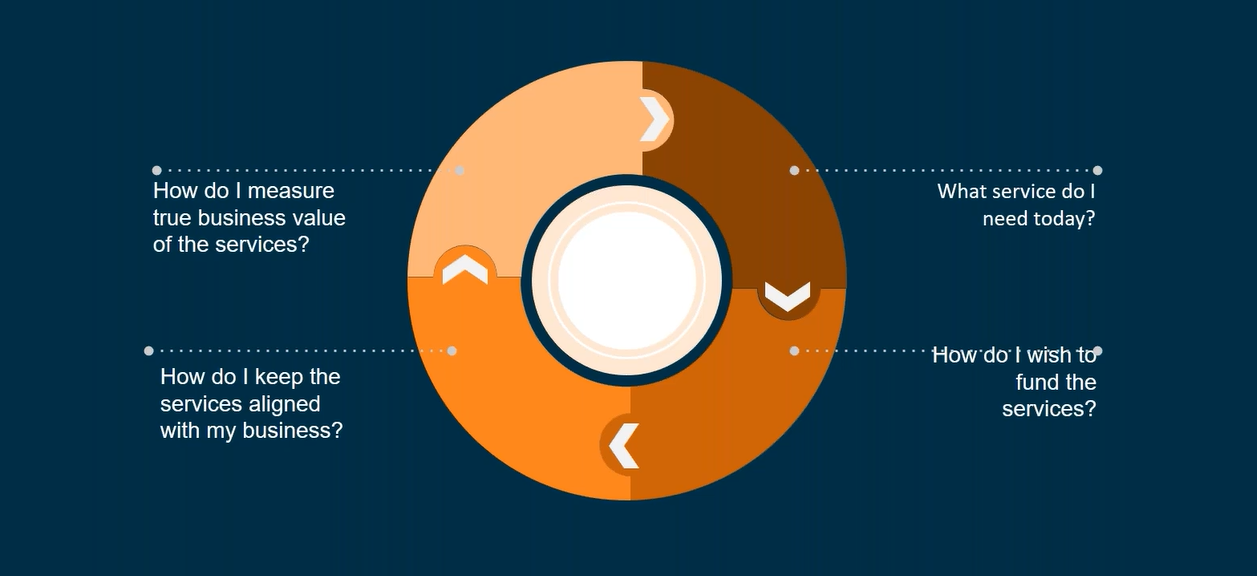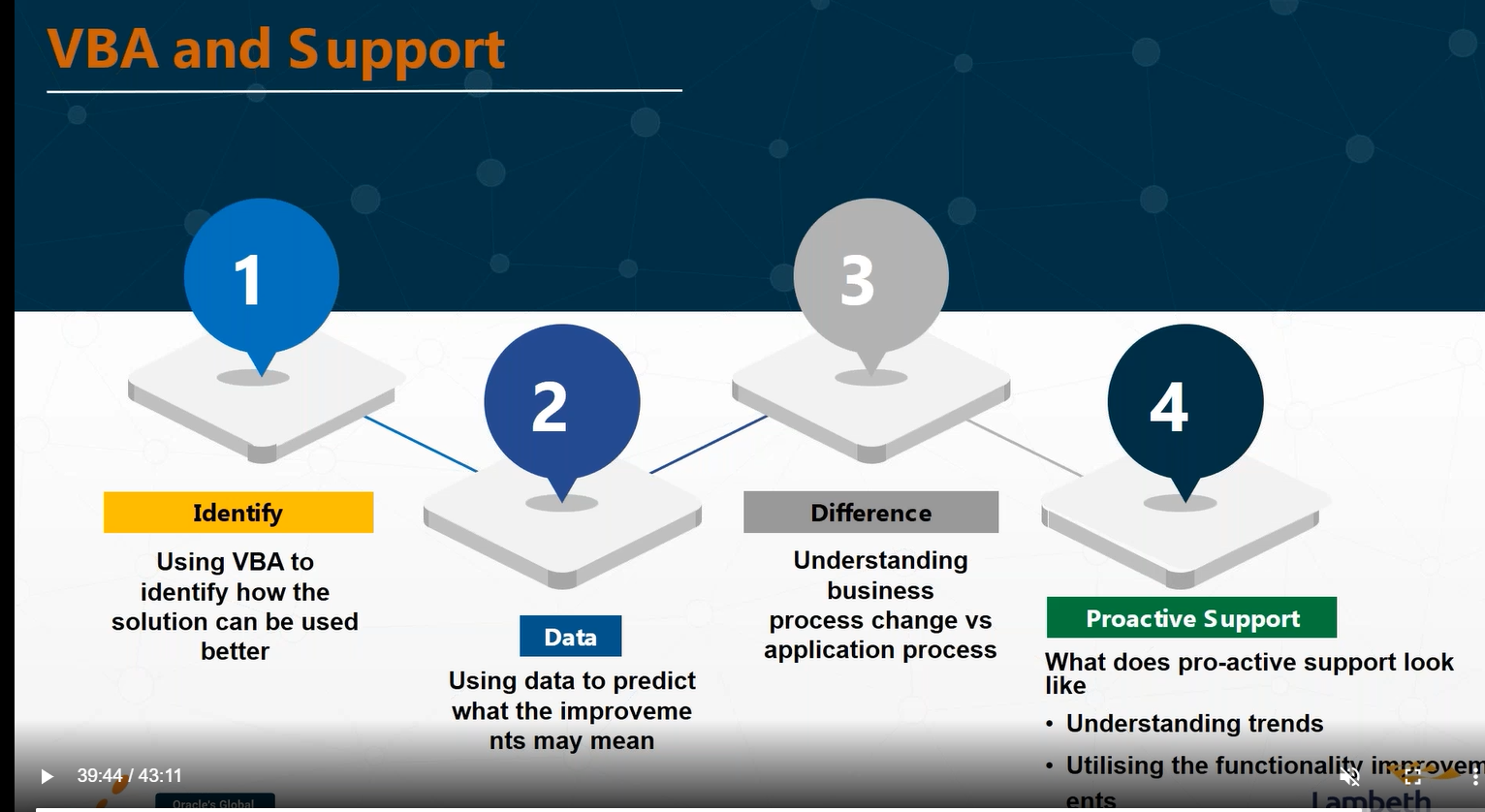Your cloud journey doesn’t stop the moment you go live. That's really the start of that transformation, and those who have seen maximum returns on their investment in the cloud are the ones that continually reassess the alignment of the system with the overall organization’s objectives.

Post go-live is not a one-time event, but it is an ongoing process where you need an external partner, who can continue assisting you even after achieving system transformation.
Therefore, what organizations should be considering when choosing a cloud services provider is more than just a one-off “support”.
The post go-live support is often a never-ending cycle. It's a wheel and Mastek can help you turn it around with Cloud Enhancement Services (CES).
Design a Post Go-Live Support Service That Remains Aligned with Your Business
The post go-live support consists of essential service domains you need to consider for a holistic set of cloud-enabling services. You also need to check if your service provider understands your post go-live cycle and if they play an active and continued role in it.
Here are a few questions you should be asking yourself before opting for a service provider.

1. What services do I need in the form of post go-live support?
You can ask yourself what services you need today, but the answer to that question will change during your journey. Also, you need to consider what services you need from your service provider or what services you are going to do yourselves because the days of total outsourcing are behind now. Therefore, more and more organizations are looking for hybrid in-source versus selectively outsource services when it comes to post go-live support.
2. How do I wish to fund these services?
Once you have decided on that what you and your cloud managed services providers are going to do, look at how you wish to fund these decisions because it isn't just an outright cost. It's at risk versus flexibility value for money and all the other considerations you have as part of the procurement cycle.
3. How do I keep the post go-live support services aligned with your business?
The third question is about change, and your organization is unlikely to be any different during the duration of your journey to the cloud. So, how do you make sure the post go-live support services you've chosen can remain aligned with changes in the demand and the organization’s priorities? Managing that change is important and we want to avoid situations where systems become a restrictor or inhibitor to change. The objective here for IT is to enable businesses, which is an essential part of the cloud ethos.
4. How do I measure the true business value of the services?
People get the most out of the cloud only when they continually review their own performance and the performance of their service providers. When you're deciding on your service provider, check if they understand this need for continual reevaluation. Changes are required in the services to keep them aligned with your business and your organization’s demands - both now and in the future. If their post go-live support model lacks the agility and flexibility to do this, then you may want to question the effect of how it is the correct fit.
What Should Your Cloud Managed Services Look Like?
Your ongoing post go-live support services must maintain alignment with both the original cloud adoption business case and changes in the organizational landscape. Without a conscious decision to drive continued evolution and alignment, the default outcome will be an ongoing reduction in business value.
There are three paths in this simplistic view of the cloud world:
1. EvolveThis involves value improvement for measuring and driving business value. Focus on business outcomes and maintain alignment between systems and business demands.
2. MaintainThe value will eventually decline as the system loses business alignment. This involves overseeing value erosion and taking necessary steps to maintain the core platform. Focus on SLAs/technology KPIs.
3. SupportYou need post go-live support to overcome the value destruction of your cloud investment, and it involves a reactive, fix-on-fail approach. Focus on cost reduction and reduce the poor end-user experience. Without positive intervention, this is the default position.
Engaging an external provider to deliver post go-live support can be the right thing to do. You need a dedicated team for driving the evolution and undertaking frequent maintenance tests. This will deter the organization’s value from reducing and dismantling the hard work of that initial project.
What You Should Be Asking Your Service Provider?
You need to do various things to proactively manage a cloud service. Here are some essential domains you should be asking your cloud managed service provider for post go-live support:
Core service management
This is the glue that holds together your service and the underlying domains. It offers a bunch of service governance processes, not only for your service provider but also for your own organization. Your core service management will decide how these two can actually blend together and work in harmony.
1. Application support
Application support is inclusive of incident, event, and problem management; it may also include a bit of service request fulfillment. So, it basically involves fixing things when they break. Since application support is essential to keep the system alive, businesses should definitely opt for it.
Users only think of application support when it comes to managed services. Although it is very essential it is not everything, just 25% of what managed services are about.
2. Application enhancements
Application enhancement is all about elective change and optional changes businesses need. When you're looking at your cloud managed service providers in this space, think about how they will map into you as an organization that delivers change. So, if you're an agile organization, delivering things in the sprint, can your service provider deliver application enhancements in sprints?
Check if they can adopt sprints and other methods of delivering change if that's what your organization requires. Understand if your cloud managed service provider can follow a traditional item change and release management with caps.
3. Upgrade and environment management
Mastek is collectively working with Oracle to consume the quarterly changes. If anything happens after an upgrade, you don't know if it's something you've done or Oracle has done, so separating them out gets your stakeholders and users into the mindset that this is a continually and gradually evolving system.So, conducting a quarterly change request release can increase the client’s or the user’s perception that this is constantly changing and improving the system.
4. Business acceleration
This is where IT stops becoming a facility, potentially changes into the business driver, and actually becomes a facilitator. This is where you make sure to improve business value, do the right thing and make progress.
Sometimes, however, businesses can become too hung up on measurements like SLAs, KPIs, etc., and lose sight of a real organization, planning assessments, or business value assessments. So, the true measure of whether the service is succeeding or not is the impact on the broader organization that it serves.
How Mastek Supports You in Measuring and Monitoring the Outcomes with Value-Based Analytics
A few years ago, we ran a survey with our internal customers, to find out the key business drivers for our customers to procure Oracle Cloud solutions, and we noticed that most of our customers focused on application and technology savings.
Companies bought a new system with the business benefit in mind, but often lacked a tool to measure the business process efficiency which they can get as part of the Oracle Cloud solution.
So, we developed Value-Based Analytics (VBA) - a pre-built management reporting tool that helps in measuring and monitoring the outcomes, built on Oracle Fusion Transaction Business intelligence (OTBI). Our VBA tool is used for measuring and monitoring the outcomes, having 390+ prebuilt analyses and 140+ KPIs to give radio outputs.
For example, customers are often unable to pay the suppliers on time due to a tedious internal process. Our analytics dashboard offers a detailed breakdown of how much time your team takes to record invoices; how much time they take to approve the invoice on the system; and every time the invoice goes on hold, how much time do they spend on this resolution. With this, you will get a detailed breakdown of what areas need improvement and you can also ask for additional rebates from your suppliers in the future.
What Does a Quarter with Continuous Improvement Look Like as Part of Cloud Enhancement Services?
For a forward-looking view, Mastek always works in partnership with our clients in helping them set up cloud innovation. Our post go-live support action plan includes assessing your solutions every quarter, ensuring your Oracle Cloud investment is more productive and efficient. Our strategic, overarching goal for continuous improvement is largely categorized into two spaces:
- Engage with the service area
We try to understand what challenges you are facing, what objectives you want to achieve, and what improvements you are expecting. After an internal assessment, we give a snapshot of how you are currently utilizing the Oracle Cloud solution. Then, we decide whether we need to share the best practice around the configuration or if it is a reporting issue.
Whatever it is, we'll share the best practice as part of the exhibit phase.
As part of the innovation sessions, we also help our customers explore emerging technologies.
- Continuous improvement with innovation board
We strongly believe invoking a partnership with the customer and promoting more self-help is essential for ease of operations. We help in managing and upgrading the skills of the users within the organization, trying to reduce the manual activities of the customer, so you can function efficiently within the organization.
Our team conducts quarterly innovation sessions to explore emerging technologies like RPA, Analytics, IoT, etc. We help you become a leading-edge enterprise within the Oracle Cloud community.
A Case: How Lambeth is Using CES to Continually Reassess Oracle System’s Alignment with Their Business Objectives
For many organizations across industries, Mastek has offered a customized post-go-live support model to optimize their operations of business applications, providing the greatest chance of reaching sought-after outcomes.
One of our leading Oracle implementation clients, the London Borough of Lambeth, also opted for our Oracle Cloud Managed Services – Cloud Enhancement Services.
Here’s what Jason Martin, Independent Advisor at London Borough of Lambeth, states about the importance of Oracle Cloud Managed Services after the implementation.
“When you move into that cloud journey, you are starting to focus different. You are looking at your early life support from product delivery time perspective, but you're also looking at your issues around your support team and how that needs to look and feel as you progress through the project. Once you did move on from your go-live, it is really, really important to start thinking about your support model and to consider what your support model will look like.”
Going live with your Oracle Cloud Applications isn't the end of the project, it's just the beginning. Partner with us to build Next-Generation Managed Services around your business needs.

